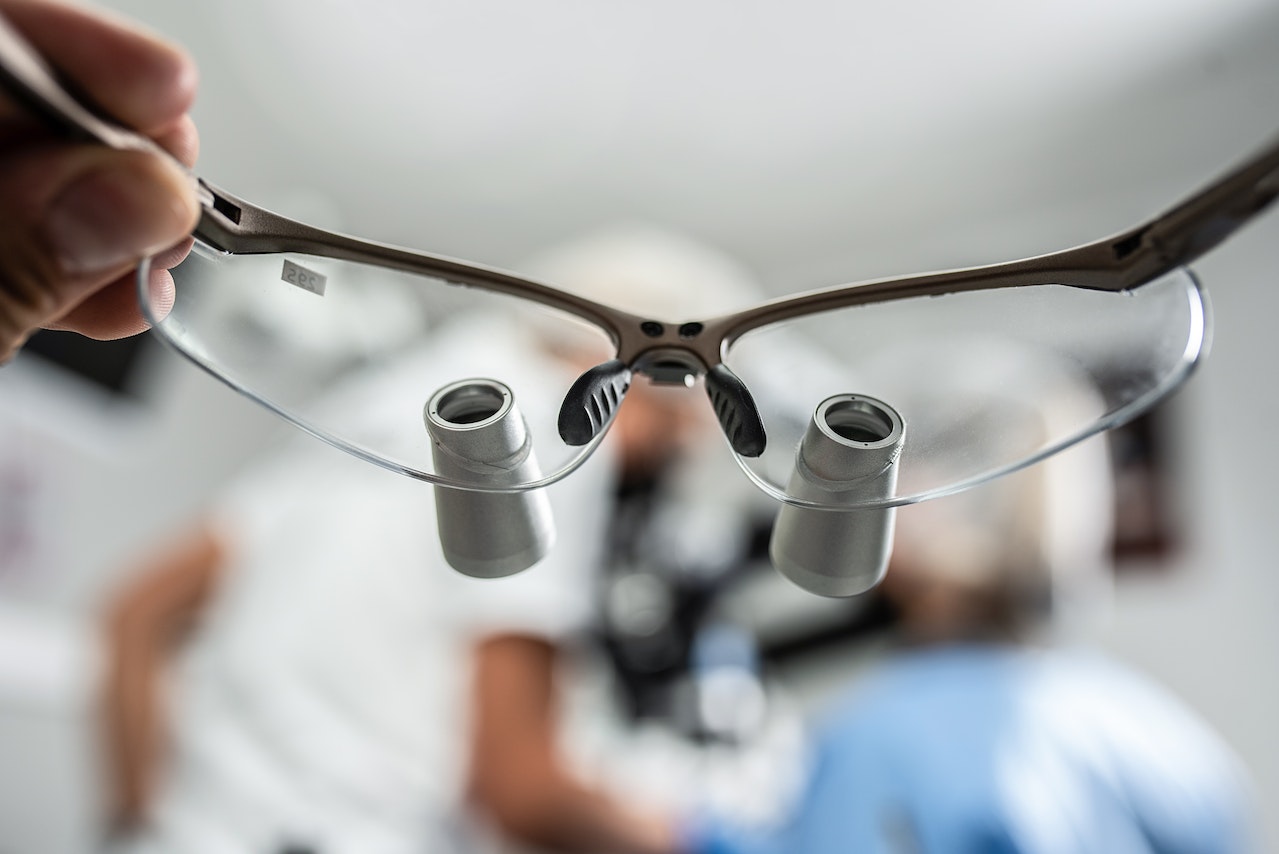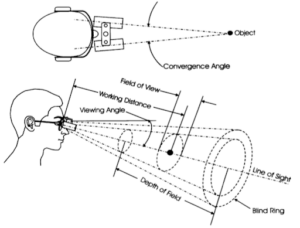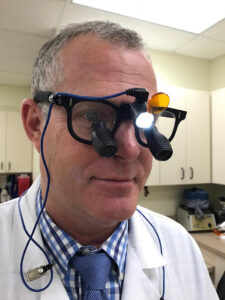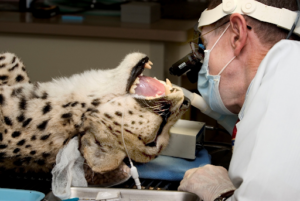
11 Aug Purchasing Veterinary Surgical or Dental Loupes
The Benefits of Veterinary Loupes
Thinking of purchasing veterinary surgical or dental loupes or maybe a headlamp?
There are four principal reasons for adopting magnifying loupes for operative dentistry or in general practice:
- Eye protection
- Enhance visualization of fine detail
- Compensate for the loss of near vision (presbyopia)
- Ensure maintenance of correct posture when doing repetitive and long procedures.
Most importantly they are just plain fun. The increased visual acuity and detail opens a new and exciting world. Your work will be easier, and the quality of your work will be better. In addition, we must admit that the general appearance of certain individuals is somewhat enhanced when wearing surgical loupes.
Defining Some Terminology
There are a few definitions that one should understand first before considering purchasing veterinary surgical or dental loupes:
Depth of field is the difference between the far and near in-focus limits of the working distance. For all systems, depth of field decreases as magnification increases.
Field of view is defined as the side-to-side size of the field or object viewed through the lens system.
Working angle (looking down angle) is the angular position of the lens systems in the plane of the user’s face. Choice of the optimal working angle is critical for preventing neck and back strain in long operations.
Some systems offer adjustable working angles, however, for systems that provide fixed angles, operators must carefully consider and select an angle suitable for their height and type of operations performed.
The desired working angle can then be customized to each individual at the initial fitting of a pair of loupes. Working angle is also known as declination angle and establishes the sight line.
Working distance is defined as the distance from the corner of the eye to the object when the object is viewed in focus. This aspect should be carefully considered prior to selecting veterinary dental loupes.
Convergent optics is the technique to create a stereoscopic image. The convergence angle is either adjustable or fixed depending on the system chosen. For fixed systems, it is essential to have very accurate measurements of the interpupillary distance prior to building the loupes. Slight errors in lens positioning are a common source of eyestrain and extraocular muscle fatigue that some surgeons experience with the use of loupes.
Accuracy of convergence optics can easily be determined by looking through the loupes at a ruler with first one eye and then the other. If the convergence angle is correct, the fields of view are identical.
Blind ring is a ring of blindness between what the user sees through the lenses and what is seen peripherally around the telescopes. There is no major difference in the size of the blind ring among loupes made by different manufacturers and all loupes have a blind ring.
This ring is approximately 3 to 4 cm wide. Loupe manufacturers rarely mention this visual obstruction—the blind ring is clinically relevant in that it may conceal a sharp instrument, resulting in unseen injury. We recommend that surgeons be familiar with the size of the blind ring that is associated with their loupes.

Figure 1: Optical terminology
Other Factors to Consider When Choosing Veterinary Dental Loupes
Magnification
Magnification of surgical loupes ranges from 1.6 to 8 power. By far, the most commonly used in veterinary dentistry is 2.5 to 3.5.
The 2.5 power magnification has a nice field of view and is very commonly used by dental hygienists, DDSs and DVMs. A 2.5 power magnification is great for general veterinary practice because this power can be used for other uses such as surgeries on small patients and or dermatology.
Most veterinary dental and oral surgery specialists use 3 to 3.5 power magnification.
One must be aware that some companies rate magnification powers differently. For example, 3.5x loupes by some companies may be equivalent to 2.5x loupes by other companies.
Remember the higher the magnification, the smaller the depth of field and width of view. This limits the clinician’s ability to accomplish tasks that demand a larger field of operation. Some manufacturers do sell extended field of view loupes at higher magnifications.
Type of Loupes
There are two basic types of surgical loupes: the “through the lens” (TTL) and “flip-up”.
TTL
In recent years, the most popular mode has been to embed the scope into the lens of the glasses, forming what is called TTL magnification. These veterinary loupes provide a slightly larger width of view since the scope is closer to the eye. They are usually custom-made, fitting the loupes to the individual’s interpupillary distance and fitting the head properly.
These loupes require very precise measurement of pupillary distance and especially of the scope’s working angle to allow for good visualization and proper neck position at the same time. Some excellent examples of TTL loupes are the RDH Elite and EyeZoom Mini from Orascoptic, ErgoVision from SurgiTel, BDR Loupes from Designs for Vision, and Micro TTL from PeriOptix.

Figure 2: TTL Loupes
Flip-up
These veterinary loupes are mounted on a hinge on the frames. The hinge allows the scopes to be raised up out of the way, and the user can adjust it for pupillary distance and angle of working angle.
Early flip-up loupes tended to be heavy and bulky, but manufacturers have greatly improved these types of loupes for comfort. One can also wear corrective glasses with Flip-ups.
Some examples of flip-up loupes are the Legacy and Panoramic flip-ups from PeriOptix and Zeiss.

Figure 3: Flip-up loupes with corrective lenses
Visual Prescriptions
Visual prescriptions can be obtained from the majority of loupe manufacturers. In order to maximize visual optics (resolution, depth of field, width of field) and to prevent eyestrain and fatigue, operators should use their normal visual correction.
The prescription is placed into the glasses in flip-up loupe systems. This design facilitates changes in the surgeon’s prescription, which can be handled by any local optician.
In through-the-lens systems, however, the prescription is intrinsic to the loupe itself in addition to the glasses. Such loupes must be sent back to the manufacturing company for any future prescription changes.
Contact lens wearers may choose not to have their correction incorporated into the loupes. Operators with strong prescriptions who also use contact lenses may choose to purchase loupes both with and without their corrections, especially if they are prone to eye irritation requiring the intermittent wearing of glasses.
Lighting
Adding an LED light to your optical setup is a very good option as well. Studies have shown a significant improvement in visual acuity when using magnification with a light source.
It is best to purchase the loupes and light from the same company so that the light attaches to the frame properly. Most operators that use attached lights quickly become hooked.
The cost of a LED light can range from a few hundred to over a thousand dollars. Whatever the cost, most operators will agree that additional lighting is worth every penny.
Even more exciting are mini cameras that can be mounted on loupes for recording procedures or to show a client something via a monitor.
Brand & Cost
The cost of surgical loupes can vary from a few hundred to a few thousand dollars.
There is no doubt that veterinary surgical loupes provide many benefits. In the quest to purchase surgical loupes it is always best to talk to the different manufacturers and to try on different types and styles of loupes until you find your perfect fit. Consider coming to the annual Veterinary Dental Forum. There will be a multitude of surgical loupe vendors present who will be eager to talk to prospective customers.
In Summary
If you are choosing your first set of loupes pay particular attention to two aspects: the power of magnification and the working length. Measure the distance from the patient to your nose to see what working length you are currently using. A comfortable seated position is best, but some doctors do prefer to stand. For your first set of loupes it is easier to adjust to a lower magnification, so consider 2x or at most 2.5x.
Surgical loupes are indispensable for any veterinarian who is venturing into dental procedures. The benefits make surgical procedures far more efficient and enjoyable to perform and ultimately lead to better outcomes for the patient with improved client satisfaction.
If you want to know more about veterinary dentistry courses, visit our site. And if you are a veterinarian in Arizona, looking for a vet dentist referral, contact me today!
Photo by . MM Dental .: https://www.pexels.com/photo/a-person-holding-a-pair-of-dental-loupes-9078185/

